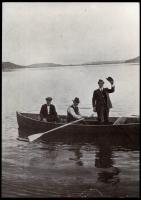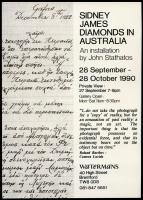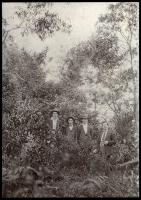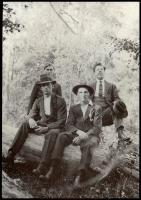In 1925, a Greek immigrant appearing before the Supreme Court of New South Wales in Australia declared that on behalf of himself and his heirs he "did absolutely renounce, relinquish and abandon" the use of his previous name, adopting instead that of SIDNEY James Diamonds; ‘Sidney’ perhaps by way of honouring his new country's principal city, and ‘Diamonds’ for possibly no better reason than a fondness for the eponymous precious stones.
Sidney James Diamonds' abiding passion was for photography. He left behind piles of sepia-toned, postcard-sized photographs including some remarkable illustrations of Australian life in the early part of the century, but it is for a small number of group portraits that he deserves to be remembered. These groups are invariably dominated by the same restless figure posing on the far right - Sidney James himself. With astonishment, one comes to realise that these are not simply self-portraits, but also highly stylised examples of staged photography, Australia herself the stage whose landscape Sidney James dominates. Not just the friends he poses with, but the very country seem reduced to the role of extras in a private theatrical production; even today, the sheer self-confidence of the enterprise remains astounding.
For anybody with an interest in photography, the fascination of these portraits is self-evident. The range of issues they give rise to includes self-representation, staged imagery, cultural archetypes and, of course, appropriation. Sidney James Diamonds in Australia (the work) can be read as an investigation; a gloss; a development; a rip-off; an ironic footnote. A work, in any case, inextricably linked to a narrative, a context which justifies and explains - in other words, the present text. But what if this text itself were a lie, a half-lie, mere falsehood and indirection? What if these are not self-portraits after all, but photographs taken by another hand? What if the landscape were not Australia, but the botanical gardens of London or Paris? What then?
John Stathatos
Περιγραφή
Τέσσερις τονισμένες αργυροτυπίες 200 Χ 130 εκ., επικολλημένες σε αλουμίνιο και πλαισιωμένες με σταχτί ξύλο. Η εγκατάσταση συμπεριλαμβάνει ηχογραφημένη μαγνητοταινία και τυπωμένο κείμενο.
Ιστορικό εκθέσεων
• 1990, Watermans Art Centre, London
• 1991, Stills Gallery, Edinburgh
• 1995, Mylos Gallery, Thessaloniki, Greece
Δημοσιεύσεις
• Sidney James Diamonds in Australia, Watermans Art Centre 1991. Fold-out card with text by the artist.
• Magazine of Cultural Studies no.3, Bristol, spring 1991
Αναφορές
• Emmanuel Cooper, “John Stathatos”, Time Out, London, 10 Oct 1990
• Charles Hall, “John Stathatos: Sidney James Diamonds in Australia”, Arts Review, 15 October 1990
• Miranda France, “Desperately seeking Diamonds”, The List, Edinburgh, 11 October 1991



